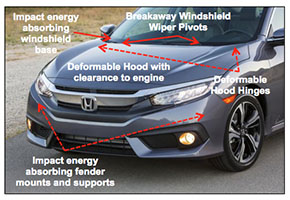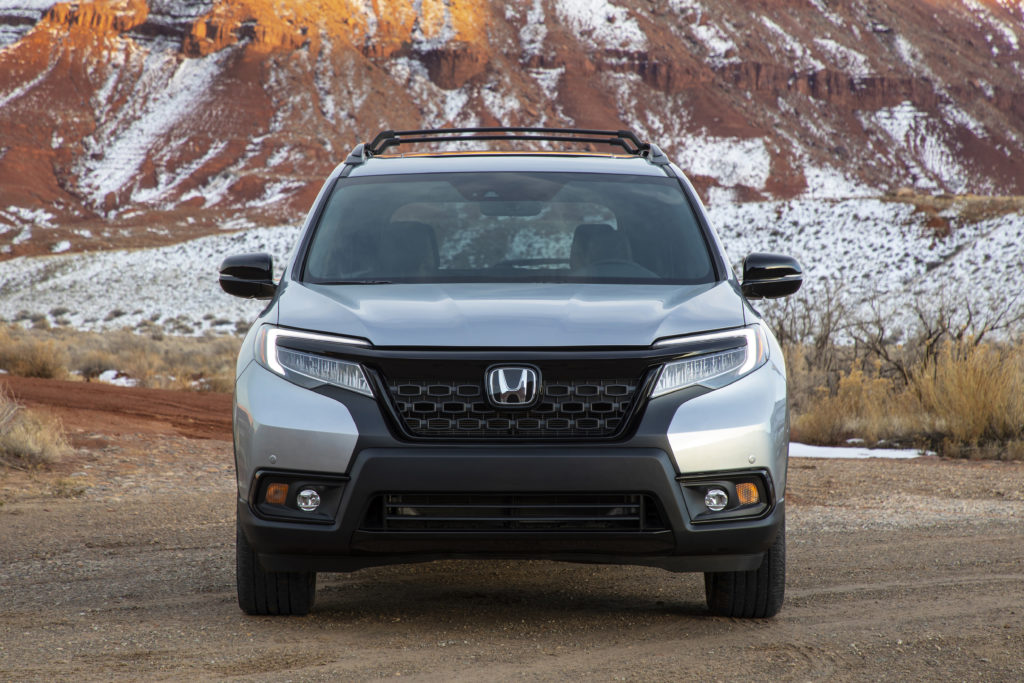
CAPA discusses testing Honda hoods tailored for pedestrian protection
By onAssociations | Business Practices | Market Trends | Repair Operations | Technology
The 2019 Honda Passport unveiled late last year is another entry in the list of Hondas which build pedestrian protection into the design of the vehicle’s front end.
“Structures in the front of the 2019 Passport are designed to help absorb energy in the event of a collision with a pedestrian,” Honda wrote in a press kit Jan. 29. “Research by Honda shows that the following features can dramatically improve a pedestrian’s chance of survival if struck by a moving vehicle.”
It listed:
• Hood is designed to deform if contact is made with either an adult or a child pedestrian
• Sufficient clearance exists between the hood and hard engine parts, allowing the hood to deform if impacted by a pedestrian
• Windshield base has a unique section structure for efficient impact energy absorption
• Energy-absorbing fender mounts and supports
• Break-away windshield wiper pivots
• Deformable hood hinges (Minor formatting edits.)
Honda records find similar features dating back more than a decade on Hondas and Acuras.

For example, Honda R&D senior chief engineer Tomiji Sugimoto in 2003 described building such technology into the 2003 Accord and other vehicles.
“The creation of pedestrian dummies and testing at our crash test facility has provided us with new insight into the dynamics of vehicle to pedestrian accidents in the real world,” Sugimoto said, according to Aug. 7, 2003, remarks provided by Honda. “We have learned that vehicle configuration and the front profile of the vehicle – areas like bumper height and lead, hood edge height, and hood length – affect the kinetic behavior of a pedestrian.
“This helped us determine the type and severity of injury. Honda’s leading study – which is the basis for the Japanese regulation – uses three different vehicle styles that more accurately reflect real world dynamics. We began implementing body design features for pedestrian protection in 1998 in Japan. We have never announced this before. But, today, U.S. models with these features include the Honda Civic, CR-V, Pilot, Element and Accord and the Acura TSX and RSX.
“The principle of our design efforts is to help absorb energy or prevent rapid deceleration of the human body. Here you can see some of these features in the 2003 Honda Accord. Where the structure of the fender to the frame was directly attached in the past, it now includes a space to absorb impact energy. We also modified the wiper pivot with slots that enable it to break away to help absorb energy. And we redesigned the hood hinge and the hood so that they bend with the force of an impact.
“Some of these changes seem simple – each results in a significant reduction in the potential for head injuries. We continue to study this issue, together with our other efforts, with the hope to further contribute to activities that improve pedestrian safety.”

Two years ago, Honda used virtually identical language to the Passport press kit to describe the current-gen 2018 Accord‘s pedestrian safety design.
Clearly, restoring these protections will be a duty of any collision repairer, even though neither the Insurance Institute for Highway Safety nor the National Highway Traffic Safety Administration track such protection. (However, the Euro NCAP and Japanese JNCAP programs do.)
But aftermarket part manufacturers also face a similar duty when providing copies of such parts. The perils of failing to do so were demonstrated in a 2016 FCAI announcement that Adelaide University’s Centre for Automotive Safety Research found steel aftermarket copies of a Holden aluminum hood would have put a pedestrian child at greater risk.
We asked the Certified Automotive Parts Association and NSF how they test such pedestrian protection as that described on the Passport. CAPA, for example, has certified 2018 Honda Accord hoods, and NSF has certified hoods for the 2003 and 2018 Accords. (Our inquiry used the current-gen 2016 Honda Civic, which Honda described using similar pedestrian protection language as the 2018 Accord and 2019 Passport.)
NSF did not respond to requests for comment. CAPA, however, offered a detailed explanation on how it tests hoods.
“Hoods must successfully demonstrate chemical, mechanical, and dimensional comparability to the car company service counterpart,” Intertek transportation technologies industry relations manager Stacy Bartnik wrote in an email. “This is accomplished by testing the car company service and CAPA-candidate parts in a laboratory. The test values of the car company service part then become the ‘standard’ that the CAPA-candidate part must meet. If the CAPA-candidate part’s test values are comparable to those of the car company service part, then the two parts should perform in a comparable manner.
“The CAPA certification program is based on comparability to the car company service part; for example if the car company service part is made of high strength steel, in order to become CAPA certified, the aftermarket part must also be made of high strength steel. Besides material composition and properties, the construction of the part is evaluated to ensure both materials and construction are comparable. The aftermarket part undergoes complete evaluation of the adhesives, welds, fasteners and strikers.”
The deformable hood hinges aren’t part of the certified hood on the 2016 Civic, Bartnik wrote.
More information:
“‘Safety for Everyone’ — Remarks by Tomiji Sugimoto”
Honda, Aug. 7, 2003
“2019 Honda Passport Press Kit”
Honda, Jan. 29, 2019
Images:
Pedestrian protection design on the 2016 Honda Civic is highlighted in this Honda image. (Provided by Honda)
The front end of the 2019 Honda Passport is designed for pedestrian protection. (Provided by Honda)
Honda tests pedestrian safety using a POLAR II dummy and 2005 Honda Accord. (Provided by Honda)
